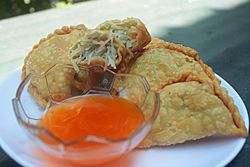Jalangkote facts for kids
 |
|
| Type | Dumpling, pastry |
|---|---|
| Course | Appetizer, snack |
| Place of origin | Indonesia |
| Region or state | South Sulawesi |
| Associated national cuisine | Indonesia |
| Created by | Makassarese or Buginese |
| Serving temperature | Hot |
Jalangkote (Lontara: ᨍᨒᨃᨚᨈᨙ) is a delicious fried pastry from South Sulawesi, Indonesia. It's a type of dumpling filled with tasty ingredients like rice vermicelli, different vegetables, potatoes, and sometimes eggs. People usually eat it hot, dipping it in a special sauce that can be spicy, sweet, and sour all at once!
This popular snack is a specialty of the Makassarese and Buginese cultures in South Sulawesi. Jalangkote is quite similar to other well-known pastries like pastel from Indonesia and panada from other parts of the world. It's a favorite snack or appetizer in Makassarese cuisine.
Contents
What is Jalangkote?
Jalangkote is a fried pastry that looks a bit like a half-moon. It has a crispy outer crust and a soft, savory filling inside. It's often enjoyed as a quick snack or a starter before a meal. The name "Jalangkote" itself comes from the local language in South Sulawesi.
Where Does Jalangkote Come From?
Jalangkote is a traditional food from the South Sulawesi province in Indonesia. This region is home to several ethnic groups, including the Makassarese and Buginese. Both groups are known for making and enjoying this unique pastry. It's a big part of their local food culture.
What's Inside a Jalangkote?
The filling of a Jalangkote is what makes it so special. It usually includes:
- Rice vermicelli: These are thin noodles made from rice.
- Vegetables: Common vegetables are carrots, green beans, and sometimes cabbage.
- Potatoes: Small pieces of potato add a soft texture to the filling.
- Eggs: Sometimes, boiled eggs are chopped up and added.
These ingredients are cooked together with spices to create a flavorful mix. The pastry dough is then wrapped around this filling and sealed.
How is Jalangkote Made?
Making Jalangkote involves a few simple steps:
- Dough: First, a dough is made from flour, water, and a little salt. It's rolled out thinly.
- Filling: The vegetables, vermicelli, and potatoes are cooked and seasoned.
- Assembly: A spoonful of the filling is placed on a piece of the dough. The dough is then folded over to create a half-moon shape. The edges are pressed together, often with a decorative crimp, to seal the filling inside.
- Frying: Finally, the Jalangkote is deep-fried until it's golden brown and crispy. This cooking method gives it its famous crunchy texture.
How Do People Enjoy Jalangkote?
Jalangkote is best eaten hot, right after it's fried. It's usually served with a special dipping sauce. This sauce is often a mix of chili, vinegar, sugar, and other spices. It gives the snack a wonderful balance of spicy, sweet, and sour flavors. People enjoy Jalangkote as a snack during the day, or sometimes as an appetizer before a main meal. It's a popular street food in South Sulawesi.
Similar Foods Around the World
Jalangkote is part of a big family of filled pastries and dumplings found in many cultures.
- Pastel: In Indonesia, there's a snack called pastel. It's very similar to Jalangkote, often filled with chicken, vegetables, or eggs. The main difference is sometimes in the spices used or the way the dough is made.
- Empanada: In Spanish-speaking countries, you'll find empanadas. These are also baked or fried pastries with various fillings, like meat, cheese, or vegetables.
- Samosa: From India, samosas are triangular fried pastries, usually filled with spiced potatoes, peas, or meat.
These foods show how different cultures have their own versions of delicious, portable, filled pastries!

